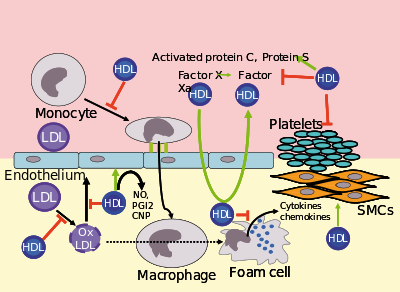High-density lipoprotein/ja: Difference between revisions
Created page with "PPARモジュレーターであるGW501516は、HDL-Cにプラスの効果を示し、LDLが問題となる場合には抗動脈硬化作用を示す。しかし、この薬物はラットのいくつかの臓器で急速ながん発生を引き起こすことが発見され、研究は中止された。" |
|||
| (23 intermediate revisions by the same user not shown) | |||
| Line 43: | Line 43: | ||
画期的な[[:en:Framingham Heart Study|フラミンガム心臓研究]]のデータから、LDLが一定レベルであれば、HDLが高値から低値に変化するにつれて心臓病のリスクは10倍に増加することが示された。しかし逆に、一定のHDLレベルでは、LDLが低値から高値に変化するにつれてリスクは3倍に増加する。 | 画期的な[[:en:Framingham Heart Study|フラミンガム心臓研究]]のデータから、LDLが一定レベルであれば、HDLが高値から低値に変化するにつれて心臓病のリスクは10倍に増加することが示された。しかし逆に、一定のHDLレベルでは、LDLが低値から高値に変化するにつれてリスクは3倍に増加する。 | ||
スタチン治療を受けているLDL値が非常に低い人でも、HDL値が十分に高くない場合はリスクが高まる。 | |||
== 関連コレステロールからHDLを推定する== | |||
{{Anchor|Estimating HDL via associated cholesterol}} | |||
臨床検査室では以前、超遠心分離またはMg<sup>2+</sup>のような2価イオンによる化学沈殿を用いて他のリポ蛋白分画を分離し、コレステロールオキシダーゼ反応の生成物を指示薬反応に結合させることによってHDLコレステロールを測定していた。基準法は現在でもこれらの技術を組み合わせて使用している。現在、ほとんどの検査室では、[[Apolipoprotein B/ja|apo B]]を含むリポ蛋白をapo Bに対する抗体を用いてブロックし、ブロックされていないHDL粒子中のコレステロールを[[Colorimetry (chemical method)/ja|比色]]酵素反応で測定する自動化された均一分析法を使用している。[[High-performance liquid chromatography/ja|HPLC]]も使用できる。サブ分画(HDL-2C、HDL-3C)の測定も可能であるが、これらのサブ分画の臨床的意義は明らかにされていない。アポA反応能の測定はHDLコレステロールの測定に使用できるが、精度は低いと考えられている。 | |||
=== 推奨範囲=== | |||
=== | [[:en:American Heart Association|米国心臓協会]]、[[:en:NIH|NIH]]、[[:en:National Cholesterol Education Program|NCEP]]は、空腹時HDL値と[[Coronary heart disease/ja|心臓病]]のリスクに関する一連のガイドラインを提供している。 | ||
{| class="wikitable" | {| class="wikitable" | ||
|- | |- | ||
! | ! レベル mg/dL | ||
! | ! レベル [[:en:Mole (unit)|mmol]]/L | ||
! | ! 解釈 | ||
|- | |- | ||
| <40/50 | | <40/50 男性/女性 | ||
| <1.03 | | <1.03 | ||
| | | HDLコレステロールが低いと、心臓病のリスクが高まると考えられている。 | ||
|- | |- | ||
| 40–59 | | 40–59 | ||
| 1.03–1.55 | | 1.03–1.55 | ||
| | | 中程度のHDLレベル | ||
|- | |- | ||
| >59 | | >59 | ||
| >1.55 | | >1.55 | ||
| | | HDL値が高く、最適な状態は心臓病に対する相関性があると考えられている。 | ||
|} | |} | ||
LDLが高くHDLが低いことは、心血管疾患のさらなる危険因子である。 | |||
== HDLの濃度と大きさの測定 == | |||
{{Anchor|Measuring HDL concentration and sizes}} | |||
技術の進歩によりコストが削減され、臨床試験でHDLの重要性が実証され続けるにつれて、HDLの濃度や大きさ(機能を示す)を低コストで直接測定する方法が広く利用されるようになり、[[atherosclerosis/ja|動脈疾患]]の進行に対する個人のリスク評価や治療法として重要視されるようになってきた。 | |||
=== 電気泳動測定 === | |||
== | HDL粒子は正味の負電荷を持ち、密度と大きさが異なるため、1950年以前から超遠心分離と[[:en:electrophoresis|電気泳動]]を組み合わせることで、血漿中のHDL粒子の濃度を列挙し、特定の体積の血漿を用いて大きさ別に分類することが行われてきた。より大きなHDL粒子は、より多くのコレステロールを運んでいる。 | ||
=== NMR測定=== | |||
== | リポ蛋白粒子の濃度およびサイズは、[[nuclear magnetic resonance/ja|核磁気共鳴]]フィンガープリンティングを用いて推定することができる。 | ||
==== 総HDL濃度と大HDL濃度の最適値 ==== | |||
==== | HDL粒子濃度は、通常、米国国立心肺血液研究所が主催する医学研究であるMESA試験に参加し、追跡されている人々に基づいて、イベント率パーセンタイルで分類される。 | ||
{| class="wikitable" | {| class="wikitable" | ||
|+ | |+ 総HDL粒子表 | ||
! | ! MESAパーセンタイル | ||
! | ! 総HDL粒子数 [[:en:mole (unit)|μmol]]/L | ||
! | ! 解釈 | ||
|- | |- | ||
| >75% | | >75% | ||
| >34.9 | | >34.9 | ||
| | | 総HDL粒子濃度が最も高く(最適)、心血管疾患発症率が最も低い者 | ||
|- | |- | ||
| 50–75% | | 50–75% | ||
| 30.5–34.5 | | 30.5–34.5 | ||
| | | 総HDL粒子濃度が中程度に高く、心血管疾患発症率が中程度の者 | ||
|- | |- | ||
| 25–50% | | 25–50% | ||
| 26.7–30.5 | | 26.7–30.5 | ||
| | | 総HDL粒子濃度が低く、心血管疾患の罹患率が高い。 | ||
|- | |- | ||
| 0–25% | | 0–25% | ||
| <26.7 | | <26.7 | ||
| | | 総HDL粒子濃度が最も低く、心血管疾患発症率が最も高い者 | ||
|} | |} | ||
{| class="wikitable" | {| class="wikitable" | ||
|+ | |+ 大(保護的)HDL粒子 表 | ||
! | ! MESAパーセンタイル | ||
! | ! 大HDL粒子数 [[mole (unit)|μmol]]/L | ||
! | ! 解釈 | ||
|- | |- | ||
| >75% | | >75% | ||
| >7.3 | | >7.3 | ||
| | | 大HDL粒子濃度が最も高く(最適)、心血管疾患発症率が最も低い人 | ||
|- | |- | ||
| 50–75% | | 50–75% | ||
| 4.8–7.3 | | 4.8–7.3 | ||
| | | 大HDL粒子濃度が中程度に高く、心血管疾患発症率が中程度の者 | ||
|- | |- | ||
| 25–50% | | 25–50% | ||
| 3.1–4.8 | | 3.1–4.8 | ||
| | | 大HDL粒子濃度が低く、心血管疾患の罹患率が高い。 | ||
|- | |- | ||
| 0–25% | | 0–25% | ||
| <3.1 | | <3.1 | ||
| | | 大HDL粒子濃度が最も低く、心血管疾患発症率が最も高い。 | ||
|} | |} | ||
経時的なアテローム性動脈硬化イベントの発生率が最も低いのは、総HDL粒子濃度が最も高く(上位4分の1、75%以上)、大HDL粒子濃度が最も高い人である。臨床検査では、LDL粒子濃度、小LDL粒子濃度、VLDL濃度、[[insulin resistance/ja|インスリン抵抗性]]の推定値、標準的なコレステロール脂質測定値(血漿データと上述の推定法との比較のため)など、複数の追加測定値が日常的に提供されている。 | |||
== HDLレベルを高める == | |||
{{Anchor|Increasing HDL levels}} | |||
HDL値が高いほど心血管疾患のリスクが低いという相関はあるが、HDLを増やすために使用される医薬品で健康増進効果が証明されたものはない。2017年現在、HDL値を高めるための数多くの生活習慣の改善や薬物が研究されている。 | |||
[[apolipoprotein C3/ja|アポリポ蛋白質C3]]を持つHDLリポ蛋白質粒子は、[[coronary heart disease/ja|冠動脈性心疾患]]のリスクを減少させるのではなく、むしろ増加させる。 | |||
=== 食事と運動 === | |||
食事と運動のある種の変化は、HDL値の上昇に好影響を与える可能性がある: | |||
* [[simple carbohydrates/ja|単純炭水化物]]の摂取を減らす。 | |||
* | * [[aerobic exercis/ja|有酸素運動]]をする。 | ||
* [[ | * [[Weight loss/ja|減量]]する。 | ||
* [[Weight loss]] | * [[avocado/ja|アボカド]]の摂取 | ||
* [[ | * [[magnesium/ja|マグネシウム]]サプリメントはHDL-Cを上昇させる。 | ||
* [[ | * 食事に[[Dietary fiber/ja|水溶性食物繊維]]を加える。 | ||
* | * 魚油や[[Linseed oil/ja#Nutritional supplement|フラックスオイル]]などの[[omega-3 fatty acids/ja|オメガ3脂肪酸]]の摂取。 | ||
* | * [[unsaturated fat/ja|不飽和脂肪]]の摂取を増やす。 | ||
* | * 食事からの[[trans fat/ja|トランス脂肪酸]]の除去 | ||
* | |||
ほとんどの[[saturated fats/ja|飽和脂肪]]は程度の差こそあれHDLコレステロールを増加させるが、総コレステロールやLDLコレステロールも増加させる。 | |||
=== 娯楽薬物=== | |||
HDL値は[[smoking cessation/ja|禁煙]]、または軽度から中等度の[[Alcohol and cardiovascular disease/ja|アルコール]]摂取によって増加する。 | |||
[[Cannabis (drug)/ja|大麻]]未調整の分析では、過去および現在の大麻使用はHDL-C値の上昇とは関連していなかった。 4635人の患者を対象に行われた研究では、HDL-C値への影響は示されなかった(P=0.78)[対照被験者(使用歴なし)、過去使用者、現在使用者のHDL-C値の平均(標準誤差)は、それぞれ53.4(0.4)、53.9(0.6)、53.9(0.7)mg/dLであった]。 | |||
[[Cannabis (drug)| | |||
外因性[[anabolic androgenic steroids/ja|同化アンドロゲンステロイド]]、特に[[17α-alkylated anabolic steroid/ja|17α-アルキル化同化ステロイド]]などの経口投与は、HDL-Cを50%以上低下させる。[[selective androgen receptor modulators/ja|選択的アンドロゲン受容体モジュレーター]]などの他の[[androgen receptor/ja|アンドロゲン受容体]]作動薬もHDLを低下させる。HDLの低下は[[reverse cholesterol transport/ja|逆コレステロール輸送]]の増加によって引き起こされるといういくつかの証拠があるため、ARアゴニストのHDL低下作用がプロアテローム性か抗アテローム性かは不明である。 | |||
=== 薬物とナイアシン === | |||
=== | |||
HDLコレステロール値を上昇させるための[[Pharmacological therapy/ja|薬理療法]]には、[[fibrate/ja|フィブラート]]および[[niacin (substance)/ja|ナイアシン]]の使用が含まれる。フィブラート系薬剤は、脂質に対する効果はあるものの、すべての原因による死亡全体に対する効果は証明されていない。 | |||
[[Pharmacological therapy]] | |||
[[Niacin (substance)/ja|ナイアシン]](ニコチン酸、[[vitamin B3/ja|ビタミンB3]]の一種)は、肝[[diacylglycerol acyltransferase/ja|ジアシルグリセロールアシルトランスフェラーゼ]]2を選択的に阻害することによりHDLを増加させ、[[niacin receptor 2/ja|ナイアシン受容体2]]として知られる受容体HM74および[[niacin receptor 1/ja|ナイアシン受容体1]]であるHM74A / GPR109Aを介して、[[triglyceride/ja|トリグリセリド]]合成および[[VLDL/ja|VLDL]]分泌を減少させる。 | |||
[[Niacin (substance)| | |||
ナイアシンの薬理学的投与(1〜3グラム/日)はHDL値を10〜30%増加させ、HDL-コレステロールを増加させる最も強力な薬剤となる。無作為臨床試験で、ナイアシンによる治療が動脈硬化の進行と心血管イベントを有意に減少させることが証明された。ナイアシン"[[Flushing (physiology)/ja|フラッシュ]]"のような副作用がない「ノーフラッシュ」として販売されているナイアシン製品は、しかし、遊離ニコチン酸を含まないため、HDLの上昇には効果がない。一方、"徐放性"として販売されている製品は、遊離ニコチン酸を含む可能性があるが、「いくつかのブランドは肝毒性がある」。フィブラートとナイアシンはともに動脈毒性のある[[homocysteine/ja|ホモシステイン]]を増加させるが、この影響は比較的多量のビタミンB群を含むマルチビタミンを摂取することで打ち消すことができるが、最も人気のあるビタミンB群カクテルを用いたヨーロッパでの複数の臨床試験では、ホモシステインの平均30%減少を示したものの、心血管系イベント発生率の減少に有益であることは示されていない。 2011年に実施された徐放性ナイアシン(ニアスパン)の試験は、スタチン治療にナイアシンを追加した患者の心臓の健康は増加しなかったが、脳卒中のリスクは増加したため、早期に中止された。 | |||
対照的に、[[statins/ja|スタチン]]の使用は高濃度のLDLコレステロールに対しては有効であるが、HDLコレステロールを上昇させる効果はほとんどないものがほとんどである。 | |||
[[Lovaza/ja|ロバザ]]はHDL-Cを増加させることが示されている。しかしながら、現在までの最良のエビデンスによると、心血管疾患の一次予防または二次予防には効果がないことが示唆されている。 | |||
[[Lovaza]] | |||
[[peroxisome proliferator-activated receptor/ja|PPAR]]モジュレーターである[[GW501516/ja|GW501516]]は、HDL-Cにプラスの効果を示し、LDLが問題となる場合には抗動脈硬化作用を示す。しかし、この薬物はラットのいくつかの臓器で急速ながん発生を引き起こすことが発見され、研究は中止された。 | |||
== こちらも参照 == | == こちらも参照 == | ||
Latest revision as of 09:26, 10 March 2024
高密度リポ蛋白質(HDL)は、リポ蛋白質の5大グループの1つである。リポ蛋白質は複数の蛋白質からなる複雑な粒子であり、細胞外の水分の中で体内の全ての脂肪分子(脂質)を輸送する。通常、粒子あたり80~100個のタンパク質で構成されている(1個、2個または3個のApoAによって組織されている)。HDL粒子は血液中を循環する間に大きくなり、より多くの脂肪分子を凝集させ、1粒子あたり最大数百の脂肪分子を輸送する。
概要
リポ蛋白質は密度/サイズ(逆相関関係)により5つのサブグループに分けられ、これは機能および心血管イベントの発生率とも相関している。脂肪分子を細胞に運ぶ大きなリポタンパク質粒子とは異なり、HDL粒子は細胞から脂肪分子を除去する。運ばれる脂質にはコレステロール、リン脂質、トリグリセリドがあり、それぞれの量は変動する。
HDL粒子の濃度を高めることは、動脈壁内のアテローム性動脈硬化症の蓄積を減少させ、突然のプラーク破裂、心血管疾患、脳卒中、その他の血管疾患のリスクを減少させることと関連している。HDL粒子は一般に「善玉コレステロール」と呼ばれるが、これは動脈壁から脂肪分子を運び出し、マクロファージの蓄積を抑え、動脈硬化の予防や退縮に役立つからである。しかし、最近の研究では、非常に高濃度のHDL粒子は、特に高血圧患者において、死亡リスクの増加や心血管リスクの増加と関連する可能性があることが示されている。
検査
HDLとLDL(低比重リポ蛋白)蛋白粒子を直接測定するのはコストが高いため、血液検査では代用値であるHDL-C、すなわちApoA-1/HDL粒子に関連するコレステロールを測定するのが一般的である。健康な人では、血中コレステロールの約30%が他の脂肪とともにHDLによって運ばれる。これはしばしば、低比重リポ蛋白粒子LDL内で運ばれると推定されるコレステロールの量と対比され、LDL-Cと呼ばれる。HDL粒子は動脈壁アテローム内を含む細胞から脂肪とコレステロールを除去し、排泄または再利用のために肝臓に戻す。したがって、HDL粒子内に運ばれるコレステロール(HDL-C)は、(LDL粒子内のコレステロールと同じであるにもかかわらず)「善玉コレステロール」と呼ばれることがある。HDL-Cの値が高い人は心血管系疾患の問題が少ない傾向があるが、HDL-Cコレステロール値が低い人(特に40 mg/dL未満または約1 mmol/L未満)は心臓病の罹患率が高くなる。健康な人の場合、本来のHDL値が高いほど心血管疾患のリスクが低下する。
HDLを差し引いた残りの血清コレステロールが非HDLコレステロールである。アテロームを引き起こす可能性のあるこれらの他の成分の濃度は、非HDL-Cとして知られている。非HDL-Cは、より良い予測因子であることが示されており、計算も容易であるため、現在では二次的なマーカーとしてLDL-Cよりも好まれている。
構造と機能
5~17nmの大きさを持つHDLは、リポタンパク質粒子の中で最も小さい。脂質に対するタンパク質の割合が最も高いため、最も高密度である。最も豊富なアポリポ蛋白はアポA-IとアポA-IIである。まれな遺伝子変異体であるアポA-1 ミラノは、動脈疾患であるアテローム性動脈硬化症の予防と回復にはるかに効果的であることが報告されている。
肝臓はこれらのリポタンパク質をアポリポタンパク質とリン脂質の複合体として合成するが、これはコレステロールを含まない扁平な球状リポタンパク粒子に似ており、最近そのNMR構造が発表された。この複合体はATP結合カセット・トランスポーターA1 (ABCA1)との相互作用によって、細胞内に運ばれたコレステロールを細胞から拾い上げることができる。レシチン-コレステロールアシルトランスフェラーゼ(LCAT)と呼ばれる血漿酵素は遊離コレステロールをコレステリルエステル(コレステロールのより疎水性の形)に変換し、リポタンパク質粒子のコアに封じ込められ、最終的に新しく合成されたHDLは球状になる。HDL粒子は血液中を循環するにつれて大きくなり、ABCG1トランスポーターやリン脂質輸送タンパク質(PLTP)との相互作用などにより、細胞や他のリポタンパク質からより多くのコレステロールやリン脂質分子を取り込む。
HDLは直接および間接的な経路によって、主に肝臓や副腎、卵巣、精巣などのステロイド生成器官にコレステロールを輸送する。HDLはスカベンジャー受容体BI(SR-BI)のようなHDL受容体によって除去される。ヒトにおいては、おそらく最も関連性の高い経路は間接的な経路であり、それはコレステリルエステル転移タンパク質(CETP)によって媒介される。このタンパク質はVLDLのトリグリセリドをHDLのコレステリルエステルと交換する。その結果、VLDLはLDLに加工され、LDL受容体経路によって循環から除去される。トリグリセリドはHDL中では安定しないが、肝リパーゼによって分解され、最終的に小さなHDL粒子が残り、細胞からのコレステロールの取り込みを再開する。
肝臓に運ばれたコレステロールは、胆汁酸に変換された後、直接的または間接的に胆汁、したがって腸に排泄される。HDLコレステロールの副腎、卵巣、精巣への運搬は、ステロイドホルモンの合成に重要である。

HDLの代謝にはいくつかの段階があり、泡沫細胞と呼ばれるアテローム性動脈硬化症動脈の脂質を多く含んだマクロファージからコレステロールを肝臓に運び、胆汁中に分泌させる。この経路は「逆コレステロール輸送」と呼ばれ、動脈硬化に対するHDLの古典的な保護機能と考えられている。
HDLには多くの脂質とタンパク質が含まれており、そのうちのいくつかは濃度は非常に低いが生物学的に非常に活性が高い。例えば、HDLとそのタンパク質および脂質成分は、酸化、炎症、内皮の活性化、凝固、血小板凝集を抑制するのに役立つ。これらの特性はすべて、HDLが動脈硬化から保護する能力に寄与していると考えられるが、どれが最も重要であるかはまだ分かっていない。さらに、HDLの小さなサブフラクションは、原虫寄生虫トリパノソーマ・ブルセイ brucei'に対する保護作用を持つ。このHDLサブフラクションはトリパノソーマ溶解因子(TLF)と呼ばれ、非常に活性が高いがTLF分子特有の特殊なタンパク質を含んでいる。
闘争・逃走反応において、急性期タンパク質のひとつでありアポリポタンパク質でもある血清アミロイドAは、副腎皮質で産生されるサイトカイン(インターロイキン1、インターロイキン6)やコルチゾールの刺激を受けて、HDL粒子に取り込まれて損傷組織に運ばれる。炎症部位では、白血球を引きつけて活性化させる。慢性炎症では、組織への沈着がアミロイドーシスとして現れる。
総HDL粒子の濃度とは対照的に、大HDL粒子の濃度は保護作用をより正確に反映すると仮定されてきた。このラージHDLと総HDL粒子の比率は大きく異なり、電気泳動法(1970年代に開発されたオリジナルの方法)または1990年代に開発された新しいNMR分光法(核磁気共鳴法および分光法も参照)を用いた、より洗練されたリポタンパク質測定法によってのみ測定される。
サブフラクション
HDLの5つのサブ分画が同定されている。 大きいもの(コレステロール除去に最も効果的)から小さいもの(最も効果的でない)まで、2a、2b、3a、3b、3cである。
疫学
男性は女性に比べてHDL濃度が顕著に低く、サイズが小さく、コレステロール含量が低い傾向がある。また、男性はアテローム性動脈硬化症心臓病の発症率が高い。最近の研究では、HDLが2型糖尿病患者における凝固亢進状態の影響のバランスをとり、これらの患者における心血管合併症の高いリスクを低下させる緩衝剤の役割を担っているという事実が確認されている。また、この研究で得られた結果から、HDLと活性化部分トロンボプラスチン時間(APTT)との間に有意な負の相関があることが明らかになった。
疫学的研究により、高濃度のHDL(60 mg/dL以上)は虚血性脳卒中や心筋梗塞などの心血管系疾患に対する予防的価値があることが示されている。低濃度のHDL(男性は40 mg/dL以下、女性は50 mg/dL以下)は動脈硬化性疾患のリスクを高める。
画期的なフラミンガム心臓研究のデータから、LDLが一定レベルであれば、HDLが高値から低値に変化するにつれて心臓病のリスクは10倍に増加することが示された。しかし逆に、一定のHDLレベルでは、LDLが低値から高値に変化するにつれてリスクは3倍に増加する。
スタチン治療を受けているLDL値が非常に低い人でも、HDL値が十分に高くない場合はリスクが高まる。
関連コレステロールからHDLを推定する
臨床検査室では以前、超遠心分離またはMg2+のような2価イオンによる化学沈殿を用いて他のリポ蛋白分画を分離し、コレステロールオキシダーゼ反応の生成物を指示薬反応に結合させることによってHDLコレステロールを測定していた。基準法は現在でもこれらの技術を組み合わせて使用している。現在、ほとんどの検査室では、apo Bを含むリポ蛋白をapo Bに対する抗体を用いてブロックし、ブロックされていないHDL粒子中のコレステロールを比色酵素反応で測定する自動化された均一分析法を使用している。HPLCも使用できる。サブ分画(HDL-2C、HDL-3C)の測定も可能であるが、これらのサブ分画の臨床的意義は明らかにされていない。アポA反応能の測定はHDLコレステロールの測定に使用できるが、精度は低いと考えられている。
推奨範囲
米国心臓協会、NIH、NCEPは、空腹時HDL値と心臓病のリスクに関する一連のガイドラインを提供している。
| レベル mg/dL | レベル mmol/L | 解釈 |
|---|---|---|
| <40/50 男性/女性 | <1.03 | HDLコレステロールが低いと、心臓病のリスクが高まると考えられている。 |
| 40–59 | 1.03–1.55 | 中程度のHDLレベル |
| >59 | >1.55 | HDL値が高く、最適な状態は心臓病に対する相関性があると考えられている。 |
LDLが高くHDLが低いことは、心血管疾患のさらなる危険因子である。
HDLの濃度と大きさの測定
技術の進歩によりコストが削減され、臨床試験でHDLの重要性が実証され続けるにつれて、HDLの濃度や大きさ(機能を示す)を低コストで直接測定する方法が広く利用されるようになり、動脈疾患の進行に対する個人のリスク評価や治療法として重要視されるようになってきた。
電気泳動測定
HDL粒子は正味の負電荷を持ち、密度と大きさが異なるため、1950年以前から超遠心分離と電気泳動を組み合わせることで、血漿中のHDL粒子の濃度を列挙し、特定の体積の血漿を用いて大きさ別に分類することが行われてきた。より大きなHDL粒子は、より多くのコレステロールを運んでいる。
NMR測定
リポ蛋白粒子の濃度およびサイズは、核磁気共鳴フィンガープリンティングを用いて推定することができる。
総HDL濃度と大HDL濃度の最適値
HDL粒子濃度は、通常、米国国立心肺血液研究所が主催する医学研究であるMESA試験に参加し、追跡されている人々に基づいて、イベント率パーセンタイルで分類される。
| MESAパーセンタイル | 総HDL粒子数 μmol/L | 解釈 |
|---|---|---|
| >75% | >34.9 | 総HDL粒子濃度が最も高く(最適)、心血管疾患発症率が最も低い者 |
| 50–75% | 30.5–34.5 | 総HDL粒子濃度が中程度に高く、心血管疾患発症率が中程度の者 |
| 25–50% | 26.7–30.5 | 総HDL粒子濃度が低く、心血管疾患の罹患率が高い。 |
| 0–25% | <26.7 | 総HDL粒子濃度が最も低く、心血管疾患発症率が最も高い者 |
| MESAパーセンタイル | 大HDL粒子数 μmol/L | 解釈 |
|---|---|---|
| >75% | >7.3 | 大HDL粒子濃度が最も高く(最適)、心血管疾患発症率が最も低い人 |
| 50–75% | 4.8–7.3 | 大HDL粒子濃度が中程度に高く、心血管疾患発症率が中程度の者 |
| 25–50% | 3.1–4.8 | 大HDL粒子濃度が低く、心血管疾患の罹患率が高い。 |
| 0–25% | <3.1 | 大HDL粒子濃度が最も低く、心血管疾患発症率が最も高い。 |
経時的なアテローム性動脈硬化イベントの発生率が最も低いのは、総HDL粒子濃度が最も高く(上位4分の1、75%以上)、大HDL粒子濃度が最も高い人である。臨床検査では、LDL粒子濃度、小LDL粒子濃度、VLDL濃度、インスリン抵抗性の推定値、標準的なコレステロール脂質測定値(血漿データと上述の推定法との比較のため)など、複数の追加測定値が日常的に提供されている。
HDLレベルを高める
HDL値が高いほど心血管疾患のリスクが低いという相関はあるが、HDLを増やすために使用される医薬品で健康増進効果が証明されたものはない。2017年現在、HDL値を高めるための数多くの生活習慣の改善や薬物が研究されている。
アポリポ蛋白質C3を持つHDLリポ蛋白質粒子は、冠動脈性心疾患のリスクを減少させるのではなく、むしろ増加させる。
食事と運動
食事と運動のある種の変化は、HDL値の上昇に好影響を与える可能性がある:
- 単純炭水化物の摂取を減らす。
- 有酸素運動をする。
- 減量する。
- アボカドの摂取
- マグネシウムサプリメントはHDL-Cを上昇させる。
- 食事に水溶性食物繊維を加える。
- 魚油やフラックスオイルなどのオメガ3脂肪酸の摂取。
- 不飽和脂肪の摂取を増やす。
- 食事からのトランス脂肪酸の除去
ほとんどの飽和脂肪は程度の差こそあれHDLコレステロールを増加させるが、総コレステロールやLDLコレステロールも増加させる。
娯楽薬物
HDL値は禁煙、または軽度から中等度のアルコール摂取によって増加する。
大麻未調整の分析では、過去および現在の大麻使用はHDL-C値の上昇とは関連していなかった。 4635人の患者を対象に行われた研究では、HDL-C値への影響は示されなかった(P=0.78)[対照被験者(使用歴なし)、過去使用者、現在使用者のHDL-C値の平均(標準誤差)は、それぞれ53.4(0.4)、53.9(0.6)、53.9(0.7)mg/dLであった]。
外因性同化アンドロゲンステロイド、特に17α-アルキル化同化ステロイドなどの経口投与は、HDL-Cを50%以上低下させる。選択的アンドロゲン受容体モジュレーターなどの他のアンドロゲン受容体作動薬もHDLを低下させる。HDLの低下は逆コレステロール輸送の増加によって引き起こされるといういくつかの証拠があるため、ARアゴニストのHDL低下作用がプロアテローム性か抗アテローム性かは不明である。
薬物とナイアシン
HDLコレステロール値を上昇させるための薬理療法には、フィブラートおよびナイアシンの使用が含まれる。フィブラート系薬剤は、脂質に対する効果はあるものの、すべての原因による死亡全体に対する効果は証明されていない。
ナイアシン(ニコチン酸、ビタミンB3の一種)は、肝ジアシルグリセロールアシルトランスフェラーゼ2を選択的に阻害することによりHDLを増加させ、ナイアシン受容体2として知られる受容体HM74およびナイアシン受容体1であるHM74A / GPR109Aを介して、トリグリセリド合成およびVLDL分泌を減少させる。
ナイアシンの薬理学的投与(1〜3グラム/日)はHDL値を10〜30%増加させ、HDL-コレステロールを増加させる最も強力な薬剤となる。無作為臨床試験で、ナイアシンによる治療が動脈硬化の進行と心血管イベントを有意に減少させることが証明された。ナイアシン"フラッシュ"のような副作用がない「ノーフラッシュ」として販売されているナイアシン製品は、しかし、遊離ニコチン酸を含まないため、HDLの上昇には効果がない。一方、"徐放性"として販売されている製品は、遊離ニコチン酸を含む可能性があるが、「いくつかのブランドは肝毒性がある」。フィブラートとナイアシンはともに動脈毒性のあるホモシステインを増加させるが、この影響は比較的多量のビタミンB群を含むマルチビタミンを摂取することで打ち消すことができるが、最も人気のあるビタミンB群カクテルを用いたヨーロッパでの複数の臨床試験では、ホモシステインの平均30%減少を示したものの、心血管系イベント発生率の減少に有益であることは示されていない。 2011年に実施された徐放性ナイアシン(ニアスパン)の試験は、スタチン治療にナイアシンを追加した患者の心臓の健康は増加しなかったが、脳卒中のリスクは増加したため、早期に中止された。
対照的に、スタチンの使用は高濃度のLDLコレステロールに対しては有効であるが、HDLコレステロールを上昇させる効果はほとんどないものがほとんどである。
ロバザはHDL-Cを増加させることが示されている。しかしながら、現在までの最良のエビデンスによると、心血管疾患の一次予防または二次予防には効果がないことが示唆されている。
PPARモジュレーターであるGW501516は、HDL-Cにプラスの効果を示し、LDLが問題となる場合には抗動脈硬化作用を示す。しかし、この薬物はラットのいくつかの臓器で急速ながん発生を引き起こすことが発見され、研究は中止された。
